Stay Up to Date
Submit your email address to receive the latest industry and Aerospace America news.
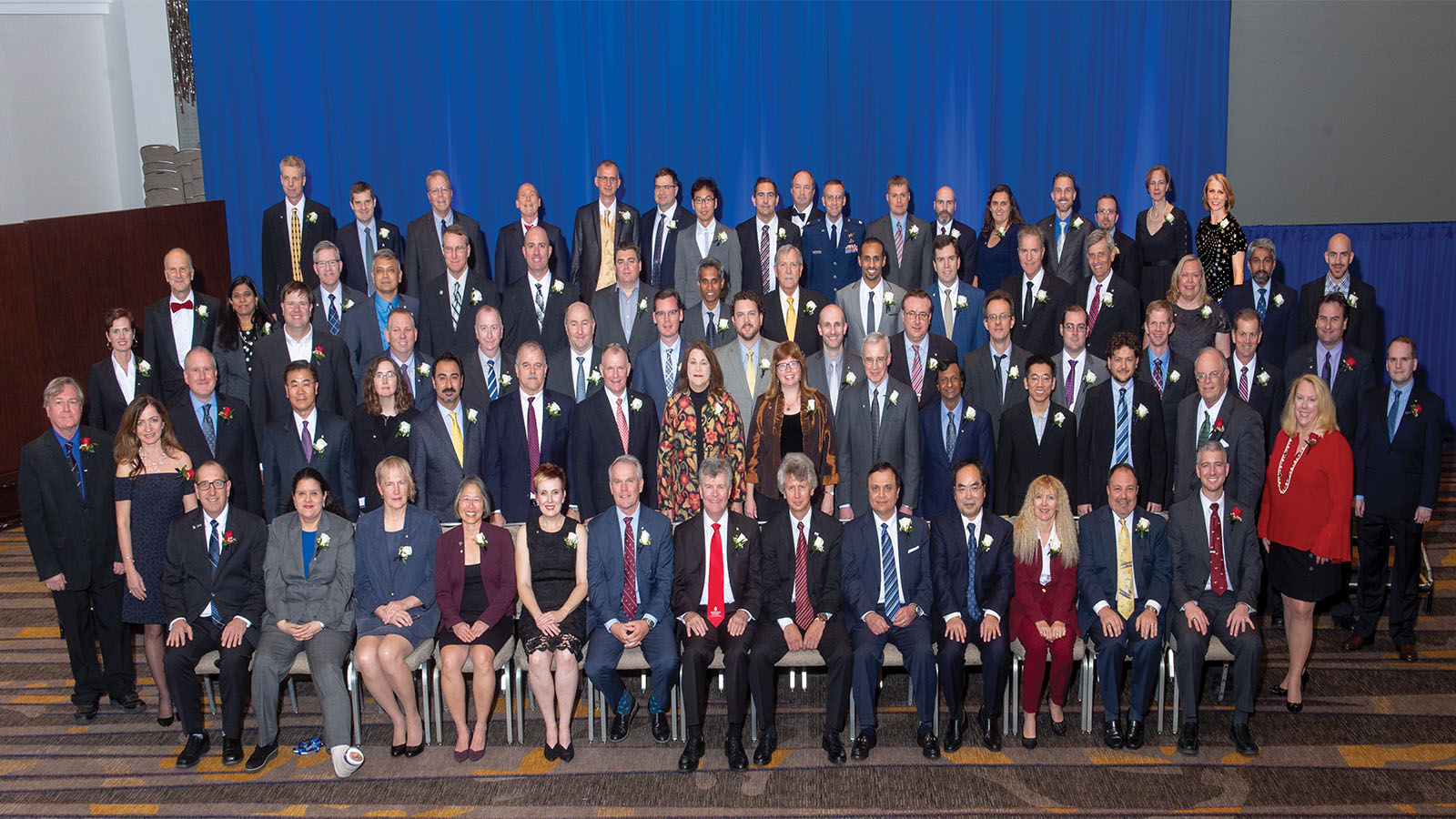
AIAA Associate Fellows
Class of 2019 AIAA Associate Fellows Honored
The Class of 2019 AIAA Associate Fellows were inducted at the AIAA Associate Fellows Recognition Ceremony and Dinner on 7 January at the Manchester Grand Hyatt San Diego in conjunction with AIAA SciTech Forum.
AIAA Fellows
AIAA Announces Its Class of 2019 Fellows And Honorary Fellows
AIAA has selected its Class of 2019 AIAA Fellows and Honorary Fellows. The induction ceremony will take place at the AIAA Aerospace Spotlight Awards Gala on 15 May 2019 at the Ronald Reagan Building and International Trade Center in Washington, DC.
Honorary Fellow is the highest distinction conferred by AIAA, and recognizes preeminent individuals who have had long and highly contributory careers in aerospace and who embody the highest possible standards in aeronautics or astronautics. The 2019 Honorary Fellows are:
G. Scott Hubbard, Stanford University
Dennis Muilenburg, The Boeing Company
Gen. Ellen M. Pawlikowski, U.S. Air Force
AIAA confers the distinction of Fellow upon individuals in recognition of their notable and valuable contributions to the arts, sciences, or technology in aeronautics or astronautics. The 2019 Fellows are:
Michael Amitay, Rensselaer Polytechnic Institute
Ella Atkins, University of Michigan
Brad Belcher, Rolls-Royce Corporation
Isaiah Blankson, NASA Glenn Research Center
Robert Canfield, Virginia Polytechnic Institute and State University
Meelan Choudhari, NASA Langley Research Center
Thomas Clemens, University of Texas at Austin
Fayette Collier, NASA Langley Research Center
Henry Garrett, Jet Propulsion Laboratory
Greg Hyslop, The Boeing Company
Keoki Jackson, Lockheed Martin Corporation
Moriba Jah, University of Texas at Austin
Larry James, Jet Propulsion Laboratory
Rakesh Kapania, Virginia Polytechnic Institute and State University
Jim Keenan, U.S. Army Aviation and Missile Research, Development, and Engineering Center
James Kenyon, Pratt & Whitney
David Klyde, Systems Technology, Inc.
Marc Kniskern, Sandia National Laboratories
Mark Miller, Dynetics, Inc.
Wing Ng, Techsburg, Inc.
Mark Pasquale, Lockheed Martin Corporation
Mostafa Rassaian, The Boeing Company
D. Brett Ridgely, Raytheon Company
Hanspeter Schaub, University of Colorado Boulder
Jaiwon Shin, NASA Headquarters
James Vasatka, The Boeing Company
Karen Willcox, University of Texas at Austin
Thomas Yechout, U.S. Air Force Academy
Xinguo Zhang, Aviation Industry Corporation of China
In 1933, Orville Wright became AIAA’s first Honorary Fellows. Today, AIAA Honorary Fellows and AIAA Fellows are the most respected names in the aerospace industry. For more information on AIAA’s Honors Program or the AIAA Honorary Fellows or Fellows Program, please contact Patricia A. Carr at [email protected].
Public Policy
2019 AIAA Key Issues and Recommendations
The Aerospace & Defense (A&D) industry is critical to our nation’s well-being, providing major contributions to national defense and homeland security, the economy, our quality of life, and education and learning. From the increasing growth and varied application of unmanned technology to the development of supersonic aircraft to the boom of activity in low Earth orbit by traditional and new commercial space players, there is much to look forward to in the coming years as government, industry, and academia together continue to imagine and create capabilities that transform our society. According to the Aerospace Industries Association, in 2017 the A&D sector:
• Supported more than 2.4 million jobs (842,900 directly employed), representing nearly 20 percent of the nation’s manufacturing workforce
• Generated nearly $865 billion in economic output, of which $422 billion is attributed to the industry’s supply chain
• Created $348.3 billion in value-added goods and services, or 1.8 percent of the U.S. GDP
• Paid out $220 billion in wages and benefits, with employees earning a salary 81 percent higher than the national average
• Received $83.9 billion from the federal government for research and development
• Exported $143 billion in goods and a positive trade balance of $85.9 billion (reducing the U.S. trade deficit by 10 percent)
The American Institute of Aeronautics and Astronautics (AIAA), the world’s largest aerospace technical society, urges lawmakers to enact and sustain policies that will enhance a robust, technologically-proficient A&D sector. We strongly believe the accompanying key issues and associated actionable recommendations are crucial to the continued health of our industry, as well as the continued competitiveness and security of our nation. As we strive to represent our nearly 30,000 individual members, 95 corporate members, and the broader aerospace community, we welcome and encourage feedback—our motive is to strengthen the profession and serve as a valued resource for decision makers.
Funding Stability and Competitiveness
The A&D industry has experienced growth in recent years because of a strong market and increased defense spending; however, major challenges exist due to mounting budget deficits, trade policy uncertainties, and a lengthy acquisitions process, as well as foreign competitors investing heavily in military modernization and scientific research. Furthermore, the current unpredictable fiscal environment creates short-term perspectives, increasing the risk of delayed aerospace initiatives and the constant threat of important programs being terminated or scaled back to suboptimal levels. A return to a regular appropriations process coupled with a long-term perspective is needed immediately so that the nation, including the A&D industrial base, can begin work on initiatives critical to a secure and economically robust future.
Recommendations:
• Permanently eliminate the arbitrary budget caps and the sequestration process imposed on defense and non-defense discretionary spending.
Provide sustained investment for basic scientific research in federal labs at levels consistent with maximizing economic growth and technological leadership.
• Provide the DOD with stable and predictable funding that supports efficient and effective multi-year acquisitions and operations.
• Streamline the defense acquisition process by tailoring oversight requirements to risk.
• Provide long-term authorizations and appropriations with top-line increases in the out years to properly fund all NASA missions in a balanced and predictable manner to meet short- and long-term program and mission requirements.
• Reauthorize the Export-Import Bank of the United States, and either confirm all open board appointments or allow the bank’s single board member to approve transactions of more than $10 million.
R&D and Innovation
Since the dawn of aviation and through the advent of the space age, the United States has been the world leader in aerospace technologies. The federal government has played an important role in supporting research and development (R&D) efforts that have led to a myriad of scientific discoveries and innovations. Despite the recent uptick in federal funding for R&D to support the A&D industry, the overall trend over the last few decades has been downward. And while the United States still represents nearly half of global aerospace R&D spending, our foreign competitors continue to aggressively invest significantly more in technologies critical to aerospace and defense. Sufficient and sustained R&D investments are therefore crucial to maintain our preeminence in this sector and to create more high-paying jobs. Just as important is moving technologies from the laboratory into the marketplace through innovative new products and services that fuel growth, exports, and expanded employment.
Recommendations:
• Invest in computational and experimental capabilities to advance military and commercial R&D.
• Ensure sufficient and stable funding for federal programs specifically toward helping industry accelerate innovation and developing products in critical areas.
• Create programs that enable greater interaction and cooperative arrangements between federal labs and research centers, academia, and industry to develop technologies needed for innovation and growth.
• Support robust, long-term federal civil aeronautics and space research and technology initiatives funded at a level that will ensure U.S. leadership.
• Offer incentives for corporate research and commercialization of that research into new products and services.
• Ensure that federal agency R&D budgets provide sufficient funding so that the United States maintains long-term technical leadership and qualitative technical superiority.
Workforce Development and Enhancement
The U.S. A&D industry currently enjoys a prominent position in terms of global competitiveness and technical superiority; however, there are justifiable concerns as the sector faces a skills gap that will threaten our future standing in the world. According to the 2018 Aviation Week Workforce Study, nearly 30 percent of the nation’s A&D workforce is over the age of 55 and 22 percent is younger than 35. The overall voluntary attrition rate is nearly 6 percent. And despite a major shift in the demographics of the United States the percentages of women and ethnic minorities working in A&D, at less than 25 percent and 5 percent, respectively, have not changed significantly in four decades.
Jobs in today’s society are heavily reliant on technology, yet our education system is not currently structured to prepare students to be STEM-literate and adaptable to rapidly changing technologies. Additionally, many schools are underfunded, teachers receive inadequate support, and there is an absence of direct mentoring. These factors have helped create a national workforce crisis. Industry leaders and policymakers alike must tackle this crisis sooner rather than later so we as a society can address the forecasted demand for highly-skilled workers.
Recommendations:
• Pass legislation that enhances the pipeline of STEM-competent workers into the U.S. economy, including initiatives aimed at underrepresented demographics.
• Promote educational and training programs for both the existing workforce and new entrants, as well as encourage K-12 teacher recruitment and professional development, through federal incentives and/or grants.
• Support programs that specifically focus on technical jobs, improve the pipeline from high schools, and provide grants to carry out these activities.
• Incentivize industry and the military to be more directly engaged with evaluating and hiring military personnel transitioning to the civilian workforce, such as creating a standard to process and categorize military skill sets.
• Pass visa legislation that welcomes and retains highly-educated international professionals who earn advanced STEM degrees from U.S. colleges and universities.
• Reform the security review process to streamline investigations, increase oversight, prioritize mission critical investigations, and promote reciprocity among agencies, while protecting sensitive information and utilizing advanced technology to appropriately manage risk.
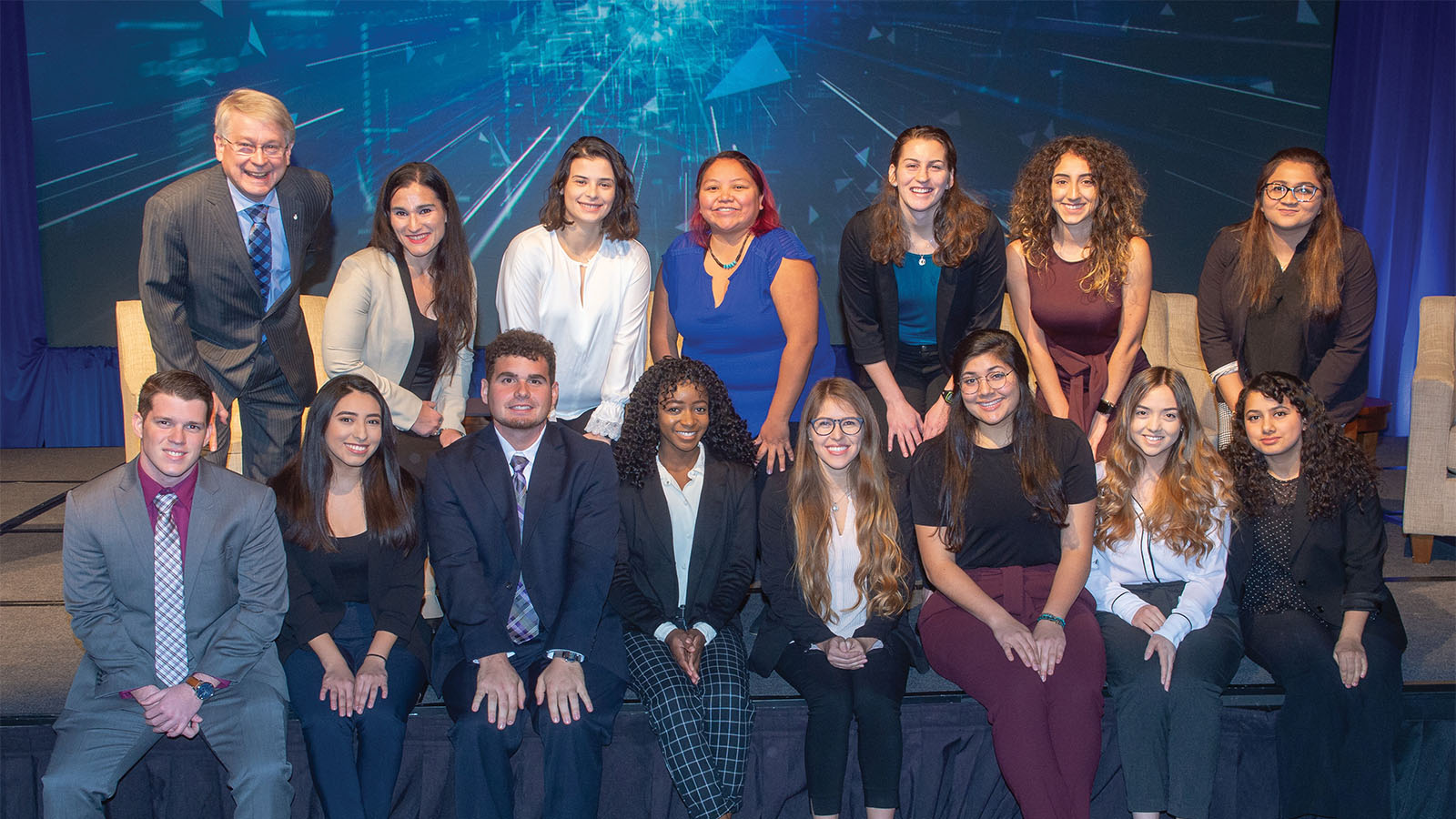
AIAA Foundation
Making an Impact: AIAA Diversity Scholars Program
Aerospace professionals seek the best answers to tough problems. We’ve learned that teams composed of members with diverse backgrounds and experiences are better problem solvers than homogeneous groups. That’s why the AIAA Foundation, collaborating with the AIAA Diversity Working Group, started the Diversity Scholars Program to bring students from underrepresented backgrounds in the aerospace industry to AIAA forums. We also know from research that direct experience with aerospace has set many current aerospace professionals on their current path. Last year, 70 Diversity Scholars attended AIAA forums!
Fifteen Diversity Scholars attended the 2019 AIAA SciTech Forum in San Diego. Thank you to Aurora Flight Sciences, a Boeing Company, for partnering with the AIAA Foundation to fund the scholars’ all-expenses-paid trip!
For more information about our educational programming or to make a donation, visit aiaafoundation.org. Information about AIAA’s diversity and inclusion plan is found at aiaa.org/diversity-and-inclusion.
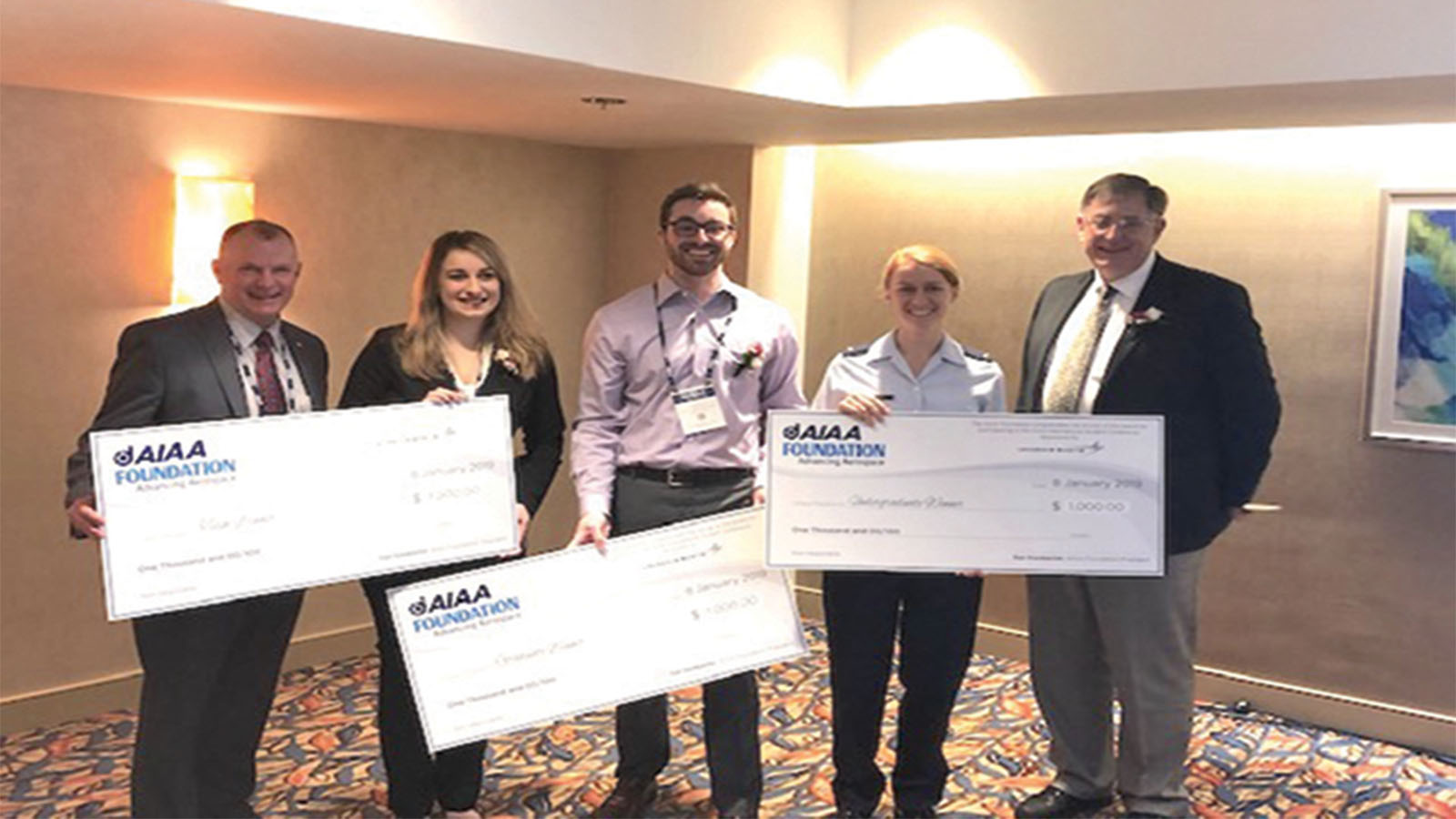
Student Conferences
2019 International Student Conference Winners
The AIAA Foundation International Student Conference takes place annually at AIAA SciTech Forum. Students who have won first place in the Regional Student Conferences present their papers at a professional technical conference. The conference offers the students a chance to showcase their research at an event where they can network with potential employers and colleagues. The 2019 International Student Conference was held on 7 January in conjunction with AIAA SciTech Forum in San Diego, CA. The awards were presented by J. D. McFarlan III, Vice President, F-35 Test & Verification, Lockheed Martin Aeronautics Company. Thank you to Lockheed Martin Corporation for sponsoring the 2019 International Student Conference.
Undergraduate Category
2nd Lt. Anna C. Demoret and Charles F. Wisniewski, United States Air Force Academy
The Impact of a Notched Leading Edge on Performance and Noise Signature of Unmanned Aerial Vehicle Propellers
Master’s Category
Matthew J. Schwartz and John D. Schmisseur, University of Tennessee Space Institute
Characterization of Near-Muzzle Ballistic Flow Fields using High Speed Shadowgraphy
Team Category
Purdue University (Steven M. Pugia, Ryan J. Clay, Matthew F. Fuehne, Margaret M. Linker, Noah C. Franks, Benjamin J. Davis, and Katherine L. Fowee)
Liquid Water Micropropulsion System for Small Satellites
For information on the AIAA Foundation International Student Conference, contact Rachel Dowdy at 703.264.7577 or [email protected].
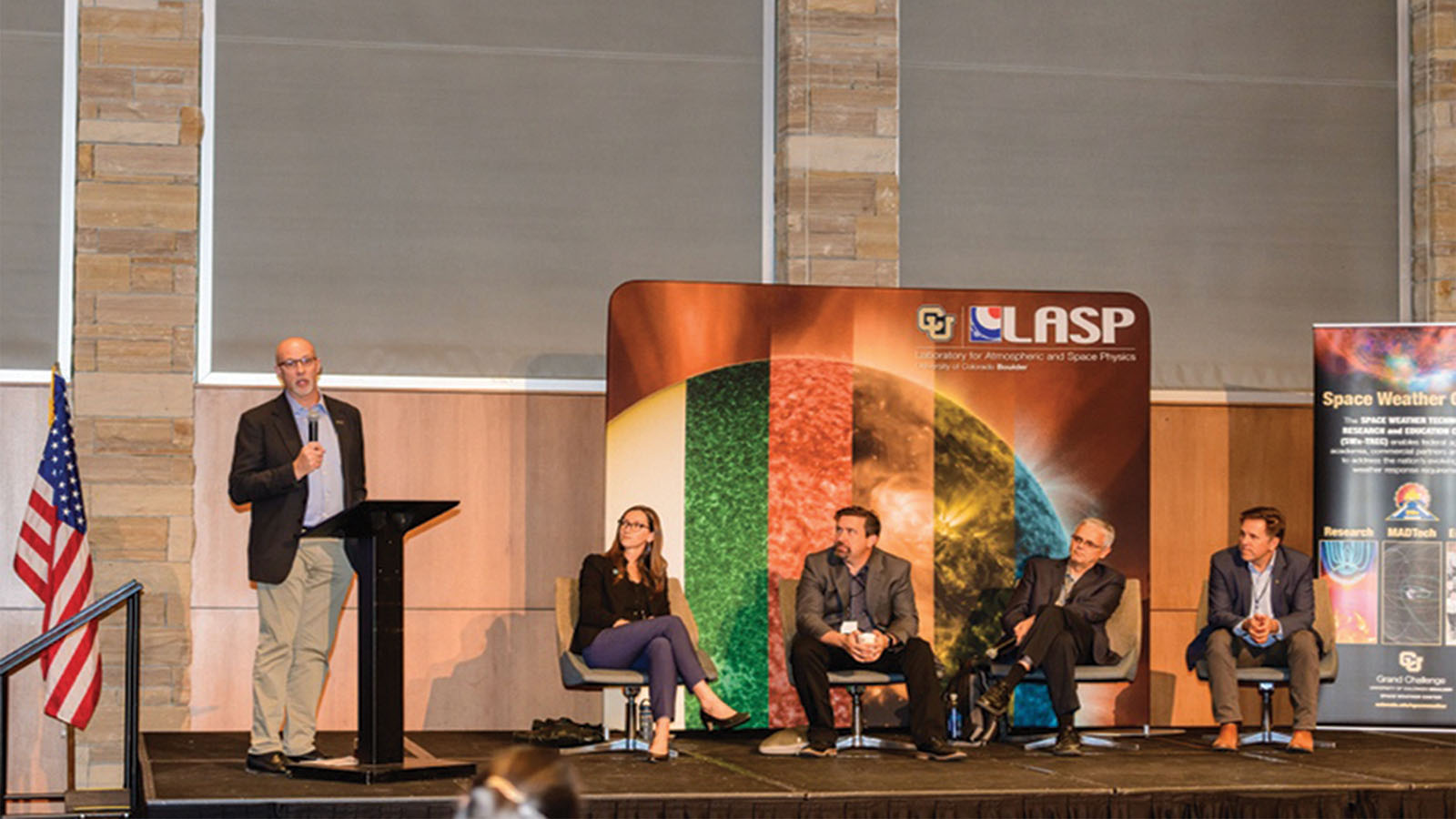
Section News
University of Colorado/LASP Hosts AIAA Rocky Mountain Section Annual Technical Symposium
By Wesley A. Kenison
On 29 October 2018, the AIAA Rocky Mountain Section held its 7th Annual Technical Symposium (ATS) at the University of Colorado (CU) South Denver Campus. Hosted by CU and the Laboratory for Atmospheric and Space Physics (LASP), the symposium featured 22 speakers, 3 panels, 10 poster presentations, 2 keynote speakers, and an exhibitor marketplace with 20 vendor/sponsor booths.
The full-day conference began with an opening address by Colorado Aerospace Champion Jay Lindell (Major General, USAF, retired), welcoming the crowd of nearly 200 attendees. The opening was followed by a panel on Space and Global Security. After the morning panel, the conference broke out into presentations on Unmanned Aircraft Systems and Advanced Manufacturing topics, followed by a panel on the Commercialization of Space. The morning presentations were rounded out with presentations on Aeronautics and Astronautics topics.
The keynote luncheon was highlighted with a presentation by United Launch Alliance (ULA) President and CEO Salvatore (Tory) Bruno, who spoke about the development and progress of ULA’s new Vulcan Rocket and ACES upper stage. Bruno also discussed the development of Sensible Modular Autonomous Return Technology (SMART) reuse concepts, which aims to recover the booster engines after first stage burnout.
A big focus of the day’s events was the subject of space weather. Afternoon presentations included a panel on the topic featuring experts from LASP, NOAA, NCAR, Ball Aerospace, and the National Solar Observatory, followed by a presentation on the Next Generation Defense Weather Mission being developed at Ball Aerospace.
The day ended with a keynote presentation by Bradley Cheetham, President and CEO of Advanced Space. In his presentation, Mr. Cheetham discussed the development of a Cislunar Autonomous Positioning System (CAPS) that he hopes will become a critical piece of infrastructure enabling cislunar navigation.
Full details of the conference, including abstracts of all presentations can be viewed on the ATS website at aiaa-rm.tech.
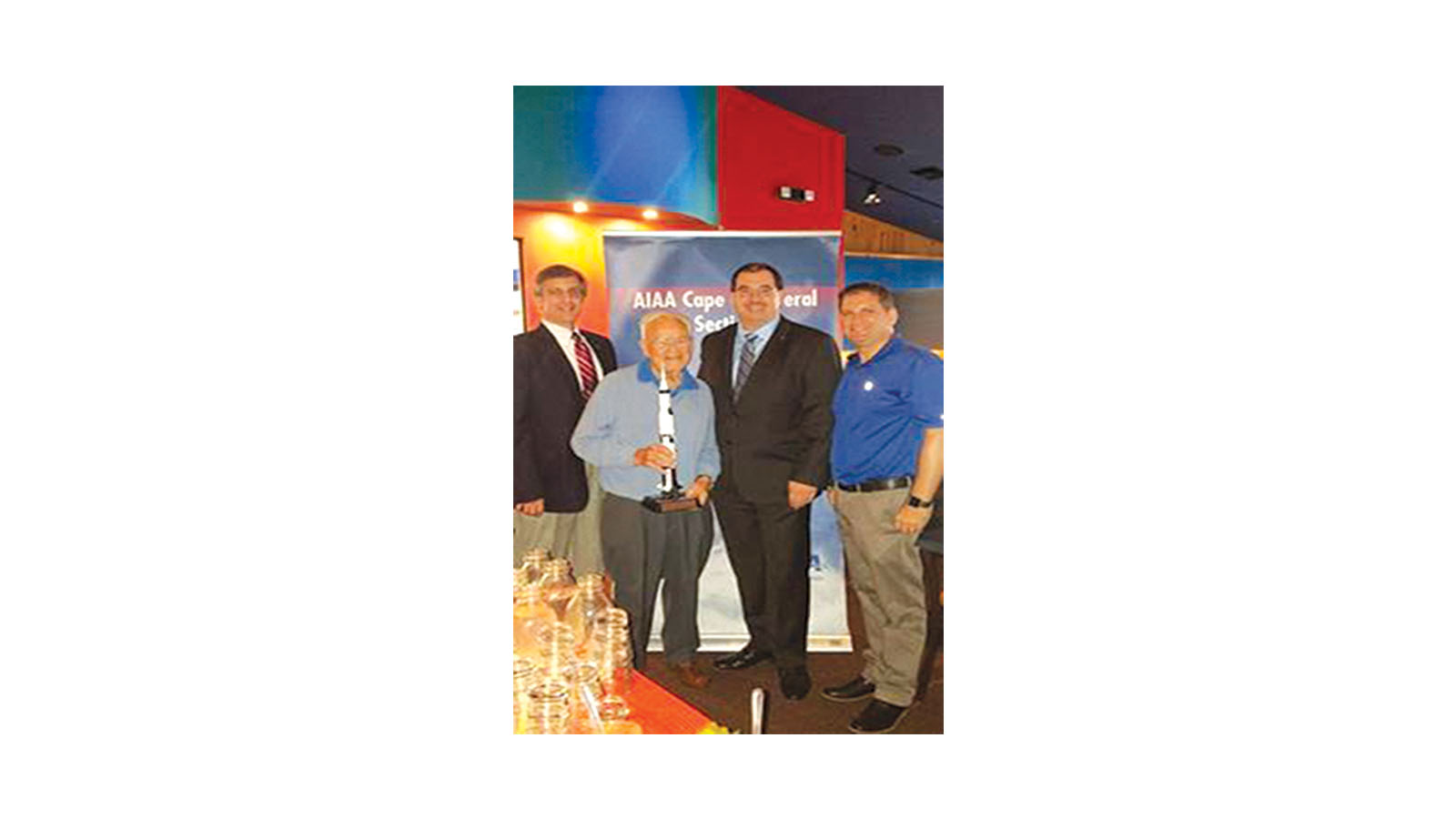
Section News
Long-Time AIAA Member Dick Russell Honored at AIAA Cape Canaveral Event
By Jacob Shriver, AIAA Cape Canaveral Section Communications Officer
The AIAA Cape Canaveral Section and Region II leadership hosted an event honoring Richard “Dick” Russell on 17 September at Rising Tide Tap & Table in Cape Canaveral, FL. The event, which was planned in complete secrecy to the man of the hour, celebrated Mr. Russell’s many career accomplishments and AIAA service. With the AIAA SPACE Forum being held in Orlando, it was the perfect chance to celebrate with members throughout Region II. AIAA members in attendance included Region II Director Kurt Polzin, former Region II Director G. Alan Lowrey, and member representation from Huntsville, Atlanta, Savannah, and Cape Canaveral sections.
Polzin and Lowrey (and former Region II Director Mark Whorton, who could not attend the event) presented Mr. Russell with a Saturn V model, personalized with the inscription “In recognition of longtime service to AIAA and with sincere personal thanks for sharing the gifts of his experience, insight, advice, and leadership.” Mr. Russell reminisced on his AIAA membership since 1965 (yes, 1965!) and gleefully described his memories of watching Saturn I-Bs and the first Saturn V ignite the Space Coast. Mr. Russell has a long history of AIAA accomplishments including AIAA Associate Fellow, Region II Director (1984–1987), Student Activities Committee (1989–1996), Young Professional Section Officer (1993), Region II Deputy Director–Finance (2008–2018), and 2015 recipient of the Special Service Citation for years of service as Region II DD–Finance. Mr. Russell resigned his deputy director position last spring; however, he continues to regularly support his local Cape Canaveral Section and Region II.
Congratulations, Dick, on an amazing AIAA and professional career!
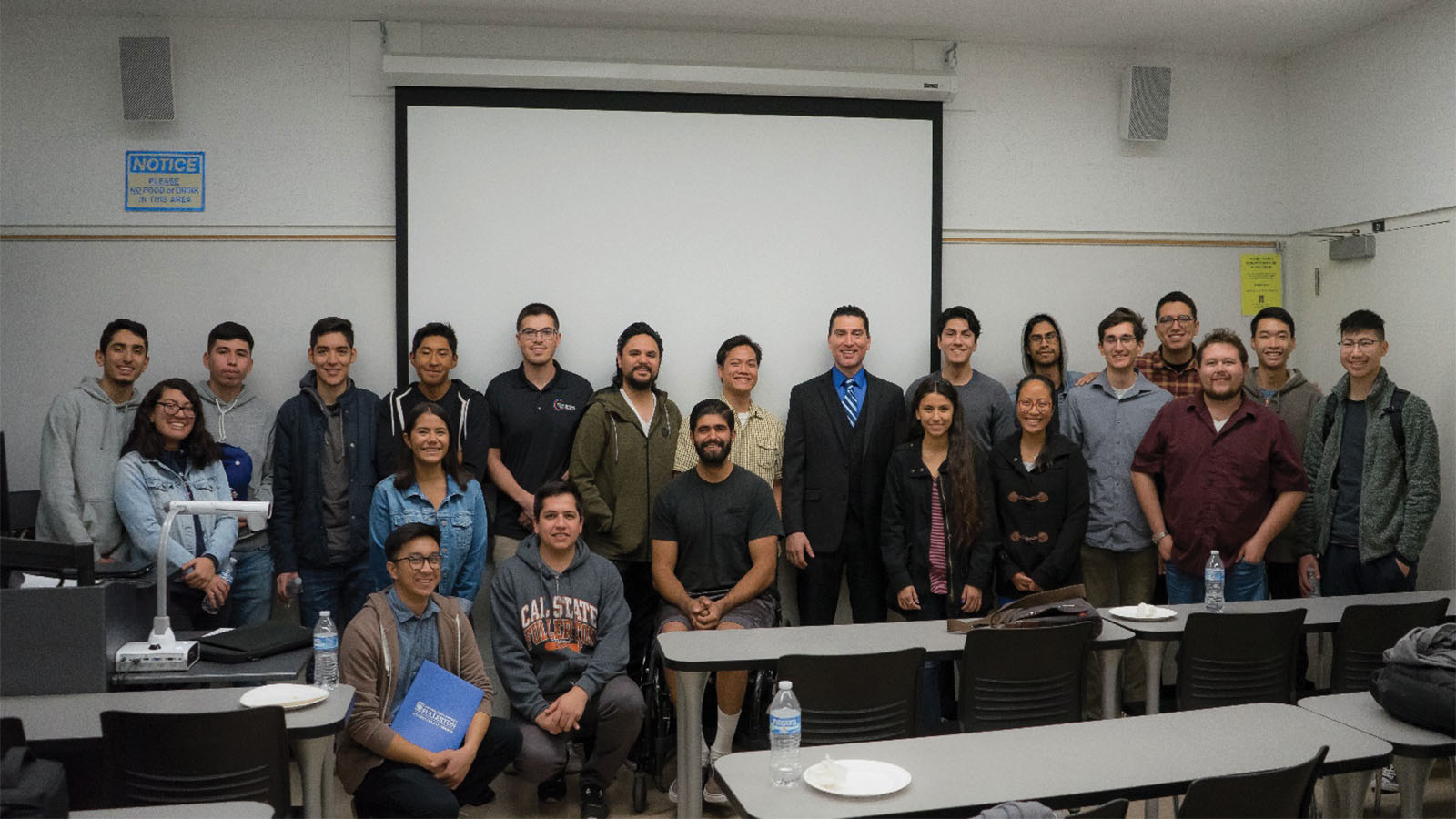
AIAA Committees
Inspiring Positive Societal Impact for Shaping A Better World
By Dr. Amir S. Gohardani, Chair, SAT IOC
On 28 November 2018, a networking/career development event was held at California State University, Fullerton (CSUF) to inspire students to engage with the AIAA Orange County (OC) Section and to educate them about the Society and Aerospace Technology Integration and Outreach Committee (SAT IOC) and other AIAA activities. In a presentation given by Dr. Amir Gohardani, undergraduate and graduate studies were discussed in addition to research endeavors and the societal impact of aerospace technology on society.
The event was organized by the AIAA CSUF Student Branch and revolved around career advancement in a competitive market. Attendees were encouraged to attend AIAA OC section’s local ASAT conference as well as AIAA’s national forums. Although the majority of the participants were engineering majors, the event was also attended by students of other majors.
SAT IOC constantly strives to enable bridges between the general public and their understanding of aerospace technology and the committee constantly adapts its methods to reach a larger portion of society. This event partnership with the AIAA OC Section to inspire students toward shaping a better world was indeed greatly appreciated by SAT IOC.
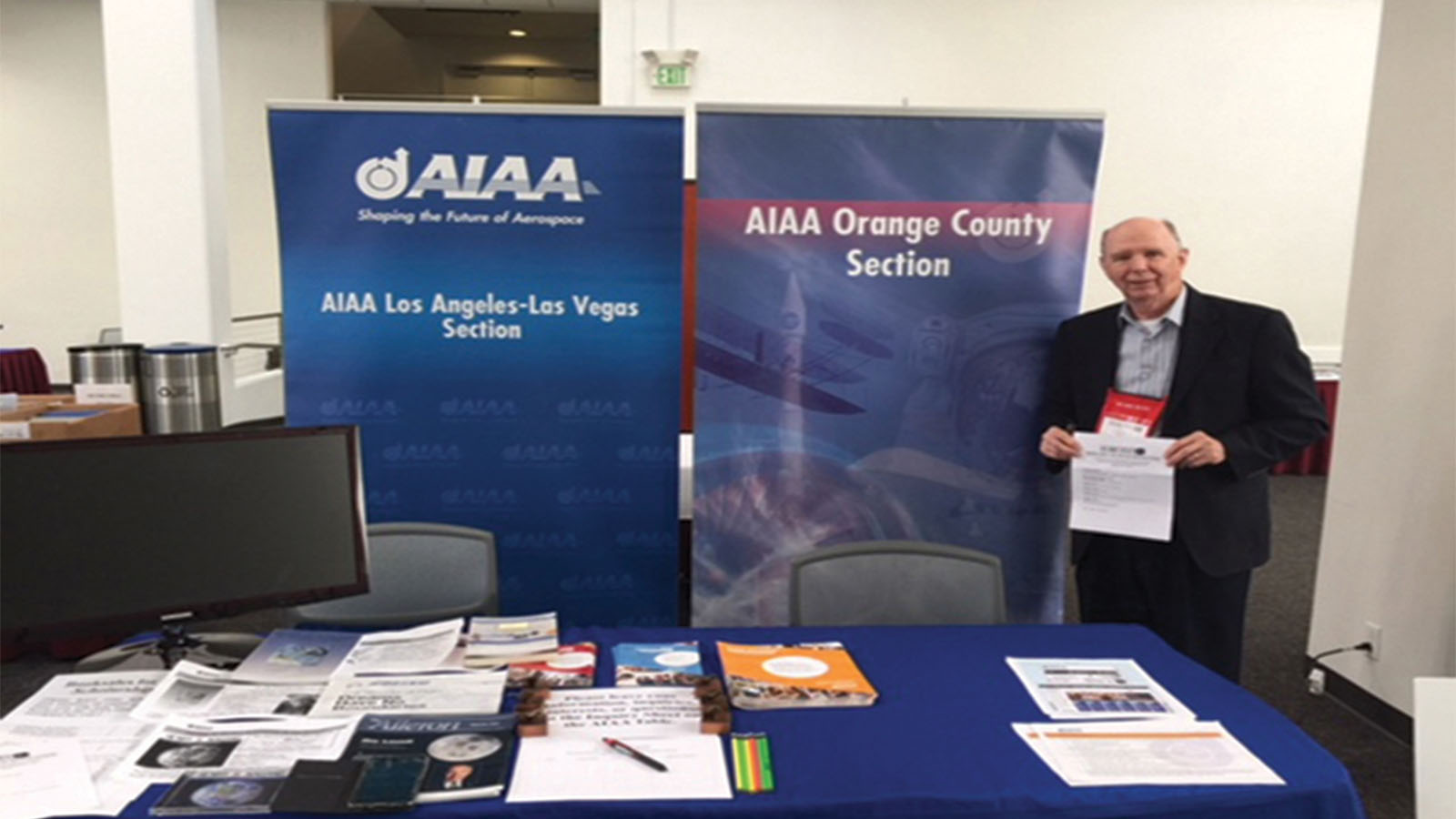
Section News
A New Beginning for the AIAA OC Section
By Dr. Amir S. Gohardani, AIAA OC Section Chair Emeritus
2019 marks a new beginning for the AIAA Orange County (OC) Section in Southern California. Most recently the section has been recognized by the following three recognitions in the AIAA Large Section category:
• 1st Place: STEM Category
• 2nd Place: Membership
• 3rd Place: Outstanding Section
Bob Welge, an AIAA Associate Fellow and one of the section’s most active members, has held a crucial role in assisting the section reaching its second-place membership recognition. Mr. Welge tirelessly works as the section’s membership officer and as a frequent RAC representative. In the past, he has also helped out as the section Treasurer and he has diligently served the council by providing his support to multiple numbers of officer positions. He was recently awarded emeritus status by AIAA and was recognized for 50 years of membership. He continues to assist the section by building on the section’s tradition of partnering with other AIAA sections. An example of such collaboration was last showcased during the 2018 Mars Society Annual Conference in Pasadena where he invited new members to join AIAA activities in two local day events with the AIAA Los Angeles/Las Vegas section.
The AIAA OC Section also partnered with the AIAA Society and Aerospace Technology Integration and Outreach Committee (SAT IOC) for the purposes of inspiring members to engage in additional AIAA OC section activities through a recent event held at California State University, Fullerton. For more information about this event, please refer to the SAT IOC article.
Stay Up to Date
Submit your email address to receive the latest industry and Aerospace America news.




